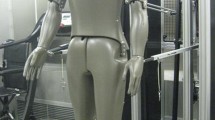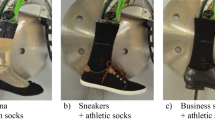Abstract
The thermal insulation properties of clothing systems can be defined through physical measurements using thermal manikins or through wear trials using human test subjects. One objective of the European Subzero project was to define the relationship between physically measured thermal insulation values of cold-protective clothing and the corresponding physiological reactions on human test subjects. Four cold-protective clothing ensembles, intended for use in temperatures between 0 and −50°C, were measured with manikins in eight European laboratories and on human test subjects in four of these laboratories. The results showed that reasonably good reproducible values from the manikin tests can be achieved (CV <8%); however, the fit of the clothing on the manikin is a critical factor. There were greater individual differences in the wear trial results. Comparing the results from the manikin and the wear trials, good agreement in the thermal insulation values was shown if the amount of accumulated sweat was low. In these situations, which are normal when using cold protective clothing, the thermal comfort can also be determined with good accuracy by means of mathematical models based on manikin results. Special situations, e.g. for highly perspiring wearers, strong wind, or high friction between garment layers, need specific modelling; some suggestions have been made as a result of the Subzero project, but further research is required.
Similar content being viewed by others
References
Bartels VT, Umbach KH (1999) Assessment of the physiological wear comfort of garments via a thermal manikin. In: Nilsson H, Holmér I (eds) Proceedings of the third international meeting on thermal manikin testing. National Institute for Working Life, Stockholm, Sweden, pp 35–38
ENV 342 (1998) Protective clothing–ensembles for protection against cold. CEN European Committee for Standardisation, Brussels, p 15
ISO/CD-11079 (2001) Evaluation of cold environments–determination of required insulation (IREQ). International Standards Organisation, Geneva, Switzerland
Meinander H (1997) Experience with a sweating thermal manikin–Ready for standard use? In: Nilsson H, Holmér I (eds) Proceedings of a European seminar on thermal manikin testing. National Institute for Working Life, Stockholm, Sweden, pp 38–42
Meinander H, Anttonen H, Bartels V, Holmér I, Reinertsen RE, Soltynski K, Varieras S (2003) Thermal insulation measurements of cold protective clothing using thermal manikins, report 4. Institute of Fibre Materials Science, Tampere University of Technology, p 61
Nilsson HO, Anttonen H, Holmér I (2000) New algorithms for prediction of wind effects on cold protective clothing. In: Kuklane K, Holmér I (eds) Ergonomics of protective clothing. Proceedings of NOKOBETEF 6. National Institute for Working Life, Stockholm, Sweden, pp 17–20
Acknowledgements
The main funding of the Subzero project was provided through the European Commission, which is greatly acknowledged. The project consortium, including eight research laboratories and five garment manufacturers, performed excellent team work.
Author information
Authors and Affiliations
Corresponding author
Rights and permissions
About this article
Cite this article
Meinander, H., Anttonen, H., Bartels, V. et al. Manikin measurements versus wear trials of cold protective clothing (Subzero project). Eur J Appl Physiol 92, 619–621 (2004). https://doi.org/10.1007/s00421-004-1139-9
Accepted:
Published:
Issue Date:
DOI: https://doi.org/10.1007/s00421-004-1139-9




